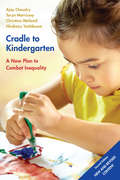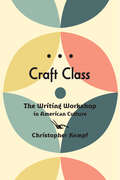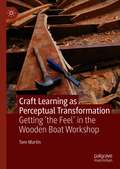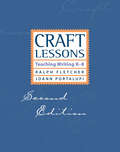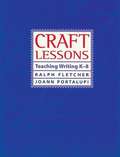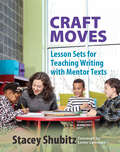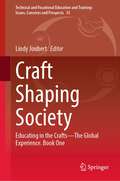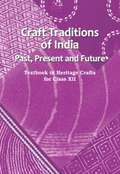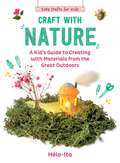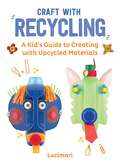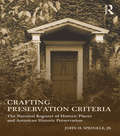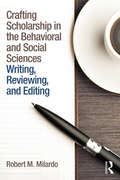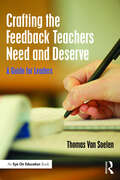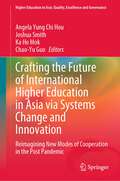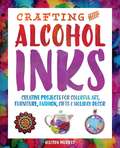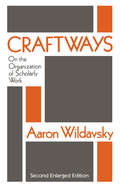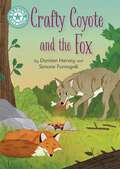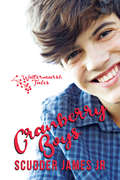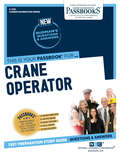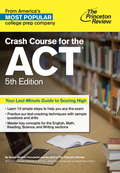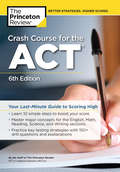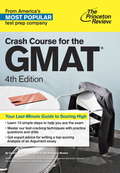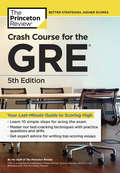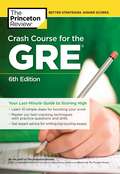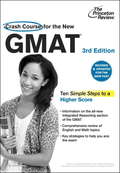- Table View
- List View
Cradle to Kindergarten: A New Plan to Combat Inequality
by Hirokazu Yoshikawa Ajay Chaudry Christina Weiland Taryn MorrisseyEarly care and education for many children in the United States is in crisis. The period between birth and kindergarten is a critical time for child development, and socioeconomic disparities that begin early in children’s lives contribute to starkly different long-term outcomes for adults. Yet, compared to other advanced economies, high-quality child care and preschool in the United States are scarce and prohibitively expensive for many middle-class and most disadvantaged families. To what extent can early-life interventions provide these children with the opportunities that their affluent peers enjoy and contribute to reduced social inequality in the long term? Cradle to Kindergarten offers a comprehensive, evidence-based strategy that diagnoses the obstacles to accessible early education and charts a path to opportunity for all children. The U.S. government invests less in children under the age of five than do most other developed nations. Most working families must seek private childcare, which means that children from low-income households, who would benefit most from high-quality early education, are the least likely to attend them. Existing policies, such as pre-kindergarten in some states are only partial solutions. To address these deficiencies, the authors propose to overhaul the early care system, beginning with a federal paid parental leave policy that provides both mothers and fathers with time and financial support after the birth of a child. They also advocate increased public benefits, including an expansion of the child care tax credit, and a new child care assurance program that subsidizes the cost of early care for low- and moderate-income families. They also propose that universal, high-quality early education in the states should start by age three, and a reform of the Head Start program that would include more intensive services for families living in areas of concentrated poverty and experiencing multiple adversities from the earliest point in these most disadvantaged children’s lives. They conclude with an implementation plan and contend that these reforms are attainable within a ten-year timeline. Reducing educational and economic inequalities requires that all children have robust opportunities to learn, fully develop their capacities, and have a fair shot at success. Cradle to Kindergarten presents a blueprint for fulfilling this promise by expanding access to educational and financial resources at a critical stage of child development.
Craft Class: The Writing Workshop in American Culture
by Christopher KempfThe hidden history of the creative writing workshop and the socioeconomic consequences of the craft labor metaphor.In a letter dated September 1, 1912, drama professor George Pierce Baker recommended the term "workshop" for an experimental course in playwriting he had been planning with former students at Harvard and Radcliffe. This was the first time that term, now ubiquitous, was used in the context of creative writing pedagogy. Today, the MFA (master of fine arts) industry is a booming one, with more than 200 programs and thousands of residencies and conferences for aspiring writers nationwide. Almost all of these offerings operate on the workshop model.In Craft Class, Christopher Kempf argues that the primary institutional form of creative writing studies, the workshop, has remained invisible before our scholarly eyes. While Baker and others marshaled craft toward economic critique, craft pedagogies consolidated the authority of elite educational institutions as the MFA industry grew. Transcoding professional-managerial soft skills—linguistic facility, social and emotional discernment, symbolic fluency—in the language of manual labor, the workshop nostalgically invokes practices that the university itself has rendered obsolete. The workshop poem or short story thus shares discursive space with the craft IPA or hand-loomed Pottery Barn rug—a space in which one economic practice rewrites itself in the language of another, just as right-wing corporatism continuously rewrites itself in the language of populism.Delineating an arc that extends from Boston's fin de siècle Society of Arts and Crafts through 1930s proletarian workshops to the pedagogies of Black Mountain College and the postwar MFA, Craft Class reveals how present-day creative writing restructures transhistorical questions of labor, education, and aesthetic and economic production. With the rise of the workshop in American culture, Kempf shows, manual and mental labor have been welded together like steel plates. What fissures does that weld seal shut? And on whose behalf does the poet punch in?
Craft Learning as Perceptual Transformation: Getting ‘the Feel’ in the Wooden Boat Workshop
by Tom MartinThrough an examination of three wooden boat workshops on the East coast of the United States, this volume explores how craftspeople interpret their tools and materials during work, and how such perception fits into a holistic conception of practical skill. The author bases his findings on first-person fieldwork as a boat builder’s apprentice, during which he recorded his changing sensory experience as he learned the basics of the trade. The book reveals how experience in the workshop allows craftspeople to draw new meaning from their senses, constituting meaningful objects through perception that are invisible to the casual observer. Ultimately, the author argues that this kind of perceptual understanding demonstrates a fundamental mode of human cognition, an intelligence frequently overlooked within contemporary education.
Craft Lessons: Teaching Writing K-8
by Ralph Fletcher JoAnn PortalupiSince its publication in 1998 Craft Lessons has become a staple in the writing classroom of both new and experienced teachers. Authors Ralph Fletcher and JoAnn Portalupi recognized the need for a succinct resource and teamed together to write the second edition of Craft Lessons: Teaching Writing K-8 . Teachers pressed for time will appreciate the practical lessons and instructional language geared to three grade level groupings: K-2, 3-4, and 5-8. This edition includes: 17 brand new lessons; mini lessons designed from teachers&’ comments about what is observed students&’ writing Revisions to other craft lessons and the resource materials sections have been expanded New ways to approach teaching using elements of craft and the reading-writing connection A subject index to find specific craft lessons with ease The authors&’ thoughts about how craft lessons fit into their newest thinking about the qualities of writing: Ideas, Design, Language, and Presentation The 95 lessons in this book provide a wealth of information for teaching leads, character, endings, stronger verbs, and much more. This new edition reestablishes Craft Lessons as the crucial desert island book for harried writing teachers everywhere
Craft Lessons: Teaching Writing K-8
by Ralph Fletcher Joann PortalupiCraft is the cauldron in which the writing gets forged. Ralph Fletcher and JoAnn Portalupi argue that too often we concentrate on the beginning and ending of the writing process--conceiving and correcting--while leaving students on their own to make a thousand critical decisions in their writing about crafting leads, voice, structure, supporting detail, setting, mood, and character. What elements of craft can we teach student writers, and at what age are they ready to learn them? This book answers both questions. Craft Lessons is the practical text for the over-scheduled writing teacher who wants to give students fresh challenges for their writing but doesn't have time to pore over dozens of trade books to do so. There are three main sections in the book: one geared for teachers of primary students, one for teachers of grades 3-4, and one for teachers of middle school writers. This developmental structure allows teachers to go directly to those craft lessons most applicable and adaptable to their own students. Each of the 78 lessons is presented on a single page in an easy-to-read format.
Craft Moves: Lesson Sets for Teaching Writing with Mentor Texts
by Stacey ShubitzHow do you choose mentor texts for your students? How do you mine them for the craft lessons you want your students to learn?In Craft Moves: Lesson Sets for Teaching Writing with Mentor Texts , Stacey Shubitz, co-founder of the Two Writing Teachers website, usestwenty recently published picture books to createmore than 180 lessons to teach various craft moves that will help your students become better writers.Each of the 184 lessons in the book includes a publisher's summary, a rationale or explanation of the craft move demonstrated in the book, and a procedure that takes teachers and students back into the mentor text to deepen their understanding of the selected craft move. A step-by-step guide demonstrates how to analyze a picture book for multiple craft moves.Shubitzintroduces picture books as teaching tools and offers ways to integrate them into your curriculum and classroom discussions. She then shares different routines and classroom procedures designed to help students focus on their writing during the writer's workshop as well as focusing how teachers can prepare for small group instruction.Using picture books as mentor texts will help your students not only read as writers and write with joy but also become writers who can effectively communicate meaning, structure their writing, write with detail, and give their writing their own unique voice.
Craft Shaping Society: Educating in the Crafts—The Global Experience. Book One (Technical and Vocational Education and Training: Issues, Concerns and Prospects #35)
by Lindy JoubertThis book focusses on the role of craft as a continuing cultural practice and the revival of disappearing skills in contemporary society. It includes twenty-five essays by highly regarded artisans, academics, technologists, entrepreneurs, businesspeople, curators, and researchers from many countries representing a wide range of global craft traditions and innovations. The authors explain their professional practices and creative pathways with knowledge, experience, and passion. They offer insightful analyses of their traditions within their culture and in the marketplace, alongside the evolution of technology as it adapts to support experimentation and business strategies. They write about teaching and research informing their practice; and they explain the importance of their tools and materials in function and form of the objects they make. The essays reveal a poignant expression of their successes, disappointments, and opportunities. This book offers case studies of how artisans have harnessed the traditions of the past alongside the latest design technologies. The authors reveal how global craft is not only a vehicle for self-expression and creativity, but also for being deeply relevant to the world of work, community and environmental sustainability. The book makes the vital link between skills, knowledge, education, and employment, and fills a much-needed niche in Technical, Vocational Education and Training TVET.
Craft Traditions of India class 12 - NCERT
by National Council of Educational Research and TrainingA fine book for the students of class 12 to get introduced to the world of aesthetics, arts and rich culture of India with Craft Traditions of India Textbook in Fine Arts. Published by the NCERT, it contains wholesome chapters that will help young students venture into the world of Indian arts. The book contains detailed information about some of the most famous pieces of arts.
Craft with Nature: A Kid's Guide to Creating with Materials from the Great Outdoors (Easy Crafts for Kids #1)
by Héloïse Charier-MaurelEnter the world of an artist with a natural spirit in this collection of crafts inspired by your surroundings! In this guided collection, young crafters and artists will find step-by-step instructions and full-color photographs that will aid them in creating decorations and playful projects using elements of the natural world. Author and artist Hélo-Ita opens with encouraging words that will inspire crafters to pay closer attention to the environment and all it has to offer when outdoors, whether they&’re on a serene hiking path in a forest, dipping into the waves at the beach, or simply playing in their own background or walking to school. You never know which materials you may find! The projects featured throughout this fully-illustrated book can be created as displayed on the page and may inspire future crafts. Types of creations include greeting cards, sculptures, light displays, kawaii rock pets, mobiles, ships in bottles, and tea light villages—all requiring the most basic supplies (tape or glue, scissors, paints or pens, thread) and whatever natural materials you source!
Craft with Recycling: A Kid's Guide to Creating with Upcycled Materials (Easy Crafts for Kids #2)
by Stéphanie BoulayIn this guided collection, young crafters and artists will find step-by-step instructions and full-color photographs that will aid them in creating decorations and playful projects using elements they have designated for reuse or upcycling. Author and artist Stéphanie Boulay, known as Lucimari, opens with encouraging words that will inspire crafters to pay closer attention to their surroundings for materials that may otherwise be thrown away, such as cans, bottles, scraps of paper or felt, unused and mismatched yarn. You never know which materials may be given a second life! The projects featured throughout this fully illustrated book can be created as displayed on the page and may inspire future crafts. Types of creations include masks, figurines or toys, mobiles, desk organizers, and more.
Crafting Preservation Criteria: The National Register of Historic Places and American Historic Preservation
by John H. Sprinkle, Jr.In 1966, American historic preservation was transformed by the passage of the National Historic Preservation Act, which created a National Register of Historic Places. Now comprising more than 1.4 million historic properties across the country, the National Register is the official federal list of places in the United States thought to be worthy of preservation. One of the fundamental principles of the National Register is that every property is evaluated according to a standard set of criteria that provide the framework for understanding why a property is significant in American history. The origins of these criteria are important because they provide the threshold for consideration by a broad range of federal preservation programs, from planning for continued adaptive use, to eligibility for grants, and inclusion in heritage tourism and educational programs. Crafting Preservation Criteria sets out these preservation criteria for students, explaining how they got added to the equation, and elucidating the test cases that allowed for their use. From artworks to churches, from 'the fifty year rule' to 'the historic scene', students will learn how places have been historically evaluated to be placed on the National Register, and how the criteria evolved over time.
Crafting Scholarship in the Behavioral and Social Sciences: Writing, Reviewing, and Editing
by Robert M. MilardoCrafting Scholarship helps readers improve their writing and publishing success in academia. Framed within the context of the editorial and peer review process, the book explores writing, editing, and reviewing in academic publishing. As such it provides unique coverage of how successful writers work, how they manage criticism, and more. Examples from successful scholars provide helpful tips in writing articles, grants, books, book chapters, and reviews. Each chapter features tools that facilitate learning including Best Practices and Writer’s Resource boxes to help maximize success, discussion questions and case studies to stimulate critical thinking, and recommended readings to encourage self exploration. A Facebook page provides an opportunity for readers to post writing updates and for instructors to share materials. Highlights include: -Insights on working with journal boards, reviewers, and contributors drawn from the author’s 30 years of experience in editing journal articles and writing books. -Describes writing quantitative and qualitative reports, theory and literature reviews, books and chapters, grants, and book reviews. -Identifies common problems academics face in writing and publishing along with practical solutions. -Explores best practices in writing peer reviews, responding to reviewers and editors, and how to calculate and interpret acceptance rates and impact factors. -Addresses how to write each section of a journal article and select keywords that facilitate digital search engines to help potential readers find an article. -Includes examples of published work and tips on writing research syntheses using meta-analytic techniques or narrative analyses. -Examines the practices of successful writers, the pros and cons of collaborations, what publishers look for, and managing criticism. -Reviews pertinent empirical literature on the core topics of writing, reviewing, and editing. Intended for graduate or advanced undergraduate courses in professional development, writing in an academic field, or research methods taught in psychology, education, human development and family studies, sociology, communication, and other social sciences, this practical guide also appeals to those interested in pursuing an academic career and new and seasoned researchers.
Crafting the Feedback Teachers Need and Deserve: A Guide for Leaders
by Thomas M. Van SoelenCrafting the Feedback Teachers Need and Deserve illuminates an often overlooked aspect of educational leadership: providing quality written feedback. This resource offers context, purpose, and techniques on how to capture and write beneficial feedback. Proven in school districts, Van Soelen’s strategies will accelerate improvement in classroom practice and result in teachers who crave feedback and use it to supervise themselves. Full of examples and complete with an assessment tool to gauge current practice, this book shares insights into providing effective observation and feedback within any teacher evaluation system.
Crafting the Future of International Higher Education in Asia via Systems Change and Innovation: Reimagining New Modes of Cooperation in the Post Pandemic (Higher Education in Asia: Quality, Excellence and Governance)
by Ka Ho Mok Joshua Smith Angela Yung Chi Hou Chao-Yu GuoThe book discusses the most essential topics in understanding the development and changes of higher educational systems in Asia after the outbreak of the pandemic, and explores the transformative, international and innovative moves from an Asian perspective. The topics covered in the book are timely in that higher education in Asia was severely limited during the tumultuous time of the pandemic, including three themes- 1. How the pandemic drives system reform and quality management; 2. How can universities maintain transnational partnerships and attract global talent; 3. How would faculty members innovate teaching pedagogy and reassess student learning experiences.This timely and well-researched book provides valuable insights into the challenges and opportunities for national, regional, and international higher education created by the recent pandemic as well as technological and geopolitical changes. The lucid analysis of key issues and trends will be useful to academics, policymakers, and researchers within Asia and beyond.Professor Jane Knight, Ontario Institute for studies in Education, University of TorontoThis book sets out important thinking for the post-pandemic era in Asian higher education. Based on valuable experience across a diverse region, this book highlights the opportunity to reimagine the future trajectory for higher education. As more of the Asia-Pacific moves toward mass and even universal systems of higher education, it exerts greater influence on higher education around the world. This book offers practical analysis that is culturally grounded in the rich civilizations of Asia about ubiquitous issues in higher education, including social equity, human agency, program quality, innovative pedagogy, academic governance, private sector initiative, knowledge building, and a new form of internationalization. It offers a sensible launchpad for a policy agenda.Professor Gerard Postiglione, Emeritus Professor, The University of Hong Kong
Crafting with Alcohol Inks: Creative Projects for Colorful Art, Furniture, Fashion, Gifts & Holiday Decor
by Allison MurrayCREATIVE DESIGNS FOR ONE-OF-A-KIND, COLORFUL PROJECTS USING VERSATILE AND AFFORDABLE ALCOHOL INKS With alcohol inks, you can add a dazzling design to just about anything. Packed with step-by-step photos, Crafting with Alcohol Inks shows how to add your personal decorative touch to everything from home decor to heart-felt gifts, including: • Etched-Top Wooden Jewelry Box • Monogram Pallet Art • Paper-Textured Table Drawers • Independence Day Suncatchers • Embossed Metal • Christmas Ornaments • Tile Coaster Set • Galaxy Ombre Sneakers • And many more!
Craftways: On the Organization of Scholarly Work
by Aaron WildavskyThe one subject that serious students want most to know about, other than their specialty, is how academic life is lived and how scholarly work is carried out. Their curiosity is equally shared by those interested in how to improve the quality and quantity of their work. With few exceptions, the time honored word-of-mouth approach is all there has been until now; how one works is rarely a subject seriously discussed in print. Craftways is intended to address these concerns and needs. Aaron Wildavsky has long been admired as one of the most productive political scientists of his generation. Repeated expressions of interest in his scholarly craft led him to gather together his essays on how he works. Included are chapters on how to read social science -"not always everyone's favorite pastime" - how to work with others on collaborative projects, and how to improve one's academic writing. The question of time, the most limited resource available to most scholars, is addressed in an amusing chapter, "The Organization of Time in Scholarly Activities Carried Out Under American Conditions in Resource-Rich Universities." He includes a section on interviewing, focusing not only on the process, but on the spirit of scholarly enterprise that should animate it. The last part of the book is purely personal, emphasizing the familial and background variables that have made Wildavsky who he is and play a large part in how he goes about his work. This wise volume, by a master of his craft, should be of broad interest to students and faculty in the social sciences.
Crafty Coyote and the Fox: Independent Reading Turquoise 7 (Reading Champion #1076)
by Damian HarveyIn this North American traditional tale, Crafty Coyote not only steals Fox's meat, but he also decides to play lots of tricks!This story is part of Reading Champion, a series carefully linked to book bands to encourage independent reading skills, developed with Dr Sue Bodman and Glen Franklin of UCL Institute of Education (IOE)Reading Champion offers independent reading books for children to practise and reinforce their developing reading skills.Fantastic stories are accompanied by engaging artwork and a reading activity. Each book has been carefully graded so that it can be matched to a child's reading ability, encouraging reading for pleasure.
Cranberry Boys (Watermarsh Tales #1)
by Scudder James JrWatermarsh Tales: Book OneIs it possible to have it all—even for a boy from a dying town of old cranberry bogs? Even for the son of religious zealots who will never accept his being gay? Even if his closeted boyfriend will never acknowledge their relationship and dates girls to distract people? Sixteen-year-old cross-country runner Zeph hopes so, because he isn’t giving up on his happily ever after. He has big plans for life after high school and for his relationship with Connor… even if Connor insists they keep it secret. Then Bronson, an old friend of Zeph’s, returns to Watermarsh after being kicked out of boarding school with secrets of his own in tow. But they keep their eyes on the prize and start a blog to impress colleges who often dismiss small-town students like them. But not even Zeph can run from everything as his home life implodes and the love triangle he’s stuck in with Bronson and Connor begins to crumble. He’ll do whatever it takes to hold on to hope—even if it means a covert trip to Bronson’s old prep school.
Crane Operator: Passbooks Study Guide (Career Examination Series #C-1749)
by National Learning CorporationThe Crane Operator (Any Motive Power Except Steam) Passbook® prepares you for your test by allowing you to take practice exams in the subjects you need to study. It provides hundreds of questions and answers in the areas that will likely be covered on your upcoming exam, including but not limited to: rules and regulations governing erection and dismantling of climber and tower cranes; computation of weights and materials to be lifted; safe loads on various types and sizes of rigging equipment including fiber and wire ropes, chain hoists, blocks, gin poles, shear legs, cranes and hydraulic rams; ability to handle practical crane erection problems; knowledge of safety measures and accident prevention; and more.
Crash Course for the ACT, 5th Edition
by Princeton ReviewYour Last-Minute Guide to a High ACT Score!This eBook edition has been specially formatted for on-screen viewing with cross-linked questions, answers, and explanations.If the big test is looming and you haven't opened a book yet, then here's your last-minute reprieve. Crash Course for the ACT details the most critical tools and rules you need to help you get a high score with limited prep time. By following the 10 simple steps in this book, you'll be on the way to your best score. Everything You Need to Help You Achieve a High Score--Condensed. · Concise, expert reviews of all question types you'll see on the test· Up-to-date information on the ACT· Essential, targeted strategies and exercises for each section of the exam Practice Your Way to Excellence.· Dozens of practice questions with detailed explanations· In-depth instructions to help you write a high-scoring essay· Guided practice in every chapter
Crash Course for the ACT, 6th Edition: Your Last-Minute Guide to Scoring High (College Test Preparation)
by Princeton ReviewYour Last-Minute Guide to a High ACT Score!Crunched for ACT prep time? Crash Course for the ACT is your last-minute solution, providing the most critical information you need to do well on the exam—plus 10 simple steps to put you on the path to your best score.Everything You Need to Help You Achieve a High Score—Condensed. · Concise, expert advice on all the question types you’ll see on the test· Up-to-date information on the ACT· Key strategies and exercises for each section of the exam Practice Your Way to Excellence.· 150+ practice drill questions and answer explanations, spread across all sections of the test· Example questions with step-by-step solutions throughout the book· In-depth instructions to help you write a high-scoring essay
Crash Course for the GMAT, 4th Edition
by Princeton ReviewYour Last-Minute Guide to a High GMAT Score!This eBook edition is formatted for on-screen viewing with cross-linked questions, answers, and explanations.If the big test is looming and you haven't opened a book yet, then here's your last-minute reprieve: a GMAT book designed for the student who's running out of time. Crash Course for the GMAT, 4th Edition, details the most critical tools and rules you need to help you get a high score with limited prep time. By following the 10 simple steps in this book, you'll be on the way to your best score. Everything You Need to Help Achieve a High Score--Condensed. · 10 simple steps for acing the exam· Concise, expert reviews of all question types you'll see on the test· Up-to-date information on the GMAT· Essential, targeted strategies and exercises for each section of the exam Practice Your Way to Perfection.· Math and Verbal drills with detailed answer explanations· In-depth instructions for writing a high-scoring Analysis of an Argument essay· Quick practice questions in every chapter
Crash Course for the GRE, 5th Edition
by Princeton ReviewYour Last-Minute Guide to a High GRE Score!This eBook edition is formatted for on-screen viewing with cross-linked questions, answers, and explanations.If the big test is looming and you haven't opened a book yet, then here's your last-minute reprieve: a GRE book designed for the student who's running out of time. Crash Course for the GRE details the most critical tools and rules you need to help you get a high score with limited prep time. By following the 10 simple steps in this book, you'll be on the way to your best score. Everything You Need to Know to Help Achieve a High Score--Condensed. · Concise, expert reviews of all question types you'll see on the test· Up-to-date information on the GRE · Essential, targeted strategies and exercises for each section of the exam Practice Your Way to Perfection.· Math and verbal drills with detailed answer explanations· In-depth instructions for writing high-scoring essays· Quick practice questions in every chapter
Crash Course for the GRE, 6th Edition: Your Last-Minute Guide to Scoring High
by Princeton ReviewThis eBook edition has been specially formatted for on-screen viewing with cross-linked questions, answers, and explanations.If the big test is coming up and you haven’t started studying, then this book is the perfect last-minute solution. Designed for the student who’s running out of time, Crash Course for the GRE details the most essential tools and tips you need to help achieve a high score on the test with limited prep time. By following the 10 simple steps in this book, you’ll be on track to your best score. Everything You Need to Help You Achieve a High Score—Condensed. · Targeted strategies and exercises for the Verbal and Math sections· Concise advice on how to conquer all question types you’ll see on the test· Up-to-date information on the GRE exam and ETS testing service Practice Your Way to Excellence.· Math and Verbal practice drills with detailed answer explanations· In-depth instructions for writing high-scoring essays· Bonus online key terms list and study plans to complete your GRE prep
Crash Course for the New GMAT, 3rd Edition
by Princeton Review10 Simple Steps to a Higher Score--in Less Than 1 Week!Crash Course for the New GMAT, 3rd Edition is designed for the student who has put off studying until the last minute. It details the most critical tools and rules students need to get a good score with only limited prep time. This ebook edition has been optimized for on-screen viewing with cross-linked questions, answers, and explanations, and includes: · 10 strategies you can quickly learn to conquer the GMAT· Practical and up-to-date information on the what, when, where and how of the next generation GMAT· Thorough reviews of all Verbal and Math topics· A comprehensive overview of the all-new Integrated Reasoning section· Dozens of practice questions with comprehensive answer explanations to help you master key techniques
